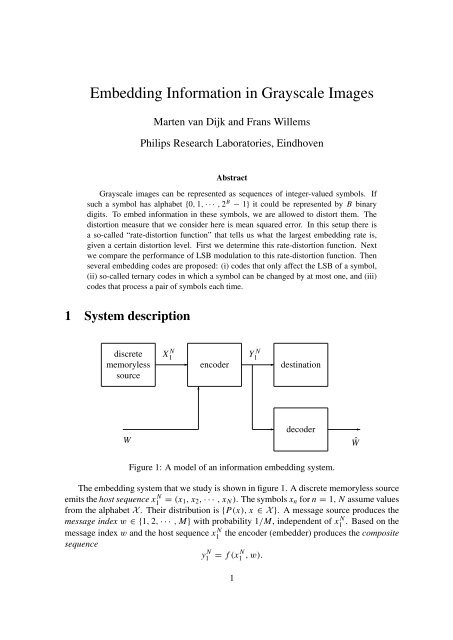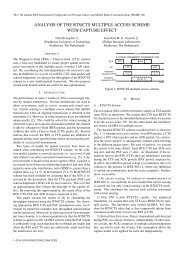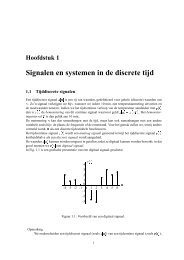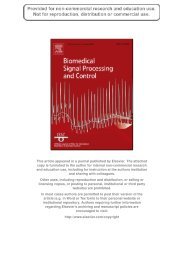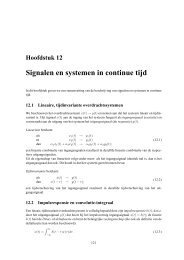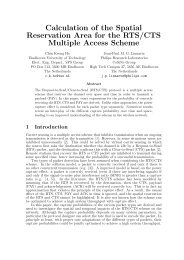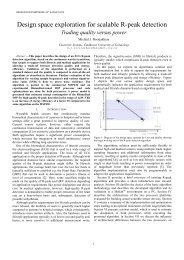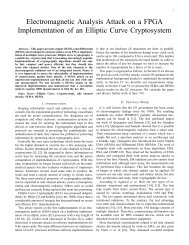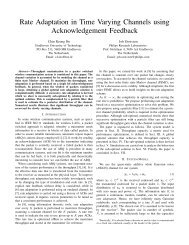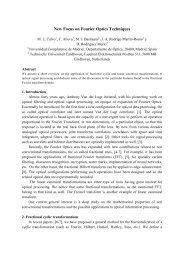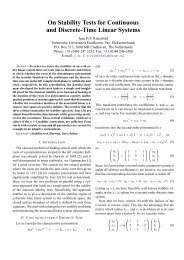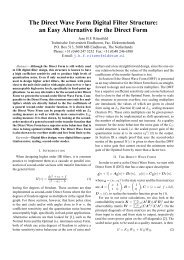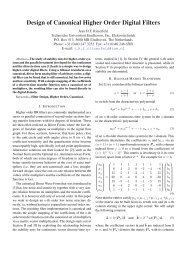Embedding Information in Grayscale Images - Signal Processing ...
Embedding Information in Grayscale Images - Signal Processing ...
Embedding Information in Grayscale Images - Signal Processing ...
You also want an ePaper? Increase the reach of your titles
YUMPU automatically turns print PDFs into web optimized ePapers that Google loves.
<strong>Embedd<strong>in</strong>g</strong> <strong>Information</strong> <strong>in</strong> <strong>Grayscale</strong> <strong>Images</strong><br />
Marten van Dijk and Frans Willems<br />
Philips Research Laboratories, E<strong>in</strong>dhoven<br />
Abstract<br />
<strong>Grayscale</strong> images can be represented as sequences of <strong>in</strong>teger-valued symbols. If<br />
such a symbol has alphabet {0, 1, · · · , 2 B − 1} it could be represented by B b<strong>in</strong>ary<br />
digits. To embed <strong>in</strong>formation <strong>in</strong> these symbols, we are allowed to distort them. The<br />
distortion measure that we consider here is mean squared error. In this setup there is<br />
a so-called “rate-distortion function” that tells us what the largest embedd<strong>in</strong>g rate is,<br />
given a certa<strong>in</strong> distortion level. First we determ<strong>in</strong>e this rate-distortion function. Next<br />
we compare the performance of LSB modulation to this rate-distortion function. Then<br />
several embedd<strong>in</strong>g codes are proposed: (i) codes that only affect the LSB of a symbol,<br />
(ii) so-called ternary codes <strong>in</strong> which a symbol can be changed by at most one, and (iii)<br />
codes that process a pair of symbols each time.<br />
1 System description<br />
discrete<br />
memoryless<br />
source<br />
X N 1<br />
✲<br />
encoder<br />
Y N<br />
1<br />
✲<br />
dest<strong>in</strong>ation<br />
✻<br />
W<br />
✲<br />
decoder<br />
✲<br />
Ŵ<br />
Figure 1: A model of an <strong>in</strong>formation embedd<strong>in</strong>g system.<br />
The embedd<strong>in</strong>g system that we study is shown <strong>in</strong> figure 1. A discrete memoryless source<br />
emits the host sequence x1<br />
N = (x 1, x 2 , · · · , x N ). The symbols x n for n = 1, N assume values<br />
from the alphabet X . Their distribution is {P(x), x ∈ X }. A message source produces the<br />
message <strong>in</strong>dex w ∈ {1, 2, · · · , M} with probability 1/M, <strong>in</strong>dependent of x1 N . Based on the<br />
message <strong>in</strong>dex w and the host sequence x1<br />
N the encoder (embedder) produces the composite<br />
sequence<br />
= f (x 1 N , w).<br />
y N 1<br />
1
The symbols from y1<br />
N = (y 1, y 2 , · · · , y N ) assume values <strong>in</strong> the alphabet Y. We require that<br />
from the composite sequence y1<br />
N the embedded message can be reconstructed, i.e. there is a<br />
decoder produc<strong>in</strong>g the estimate Ŵ = g(y1 N ) such that<br />
Pr{Ŵ ̸= W } = 0.<br />
Moreover the sequences y N 1<br />
must be “close” to x N 1<br />
, i.e. the expected distortion<br />
¯D = E[d(X1 N , Y 1 N )] = ∑ Pr{X1 N = x 1 N } Pr{W = w}d(x 1 N , f (x 1 N , w)) ≤ ,<br />
x1 N ,w<br />
where is the maximum allowable distortion and<br />
d(x1 N , y 1 N ) = 1 ∑<br />
N<br />
n=1,N<br />
D(x n , y n )<br />
is the distortion between x1<br />
N and y 1 N<br />
def<strong>in</strong>e the embedd<strong>in</strong>g-rate R as<br />
, for some specified distortion matrix D(·, ·). F<strong>in</strong>ally we<br />
R = 1 N log 2 (M).<br />
2 The ”rate-distortion” function<br />
We are obviously <strong>in</strong>terested <strong>in</strong> f<strong>in</strong>d<strong>in</strong>g codes that comb<strong>in</strong>e a large embedd<strong>in</strong>g rate R with a<br />
small distortion ¯D. Only recently several authors, e.g. [3] and [1], realized that this setup<br />
is strongly related to the “defect channel”-problem which was first <strong>in</strong>vestigated <strong>in</strong> a general<br />
form by Gelfand and P<strong>in</strong>sker [2]. In [4] the so-called ”rate-distortion function”, that<br />
corresponds to a slightly more general embedd<strong>in</strong>g model than the one we study here, was<br />
determ<strong>in</strong>ed. This function gives the maximum embedd<strong>in</strong>g rate R for a given distortion level<br />
. For our model (Z ≡ Y ) this function turns out to be<br />
R() =<br />
max<br />
{P(y|x): ∑ H(Y |X).<br />
x,y P(x)P(y|x)D(x,y)≤}<br />
Note that this is not a rate-distortion function <strong>in</strong> the usual sense.<br />
3 <strong>Grayscale</strong> symbols, mean squared error distortion<br />
0<br />
1<br />
2<br />
x y<br />
2 B − 1<br />
❅ ❅<br />
<br />
D(x, y) = (x − y) 2<br />
Figure 2: The grayscale alphabet G and mean squared error distortion.<br />
A grayscale symbol assumes a value from an <strong>in</strong>teger alphabet G. The card<strong>in</strong>ality of G<br />
should no be too small. E.g. let G = {0, 1, · · · , 2 B − 1} for some positive <strong>in</strong>teger B, then
each symbol can be represented by a vector of B b<strong>in</strong>ary digits. Now let X = Y = G. If a<br />
grayscale symbol x ∈ G is changed <strong>in</strong>to a grayscale symbol y ∈ G then the result<strong>in</strong>g squared<br />
error distortion is<br />
D(x, y) = (y − x) 2 ,<br />
<br />
see figure 2. To determ<strong>in</strong>e R() for this case, let p i =<br />
∑y−x=i P(x)P(y|x) for all <strong>in</strong>teger<br />
i, then<br />
H(Y |X) = H(Y − X|X) ≤ H(Y − X) = ∑ 1<br />
p i log 2<br />
p<br />
i<br />
i<br />
and<br />
∑<br />
P(x)P(y|x)(y − x) 2 = ∑<br />
x,y<br />
i<br />
p i i 2 .<br />
The correspond<strong>in</strong>g bound for R() can be achieved by tak<strong>in</strong>g i = y − x <strong>in</strong>dependent of x,<br />
which is possible if we assume that |G| is large and we neglect boundary-effects. Now we<br />
have to maximize ∑ i p 1<br />
i log 2 p i<br />
under the constra<strong>in</strong>t ∑ i p ii 2 ≤ . Therefore consider for<br />
some α > 0 the “Gaussian” distribution {pi ∗} where<br />
p ∗ i<br />
<br />
= exp(−αi 2 )/β,<br />
with β = ∑ i exp(−αi 2 ) and hav<strong>in</strong>g variance ∑ i p∗ i i 2 = . Then for any distribution {p i }<br />
with variance ∑ i p ii 2 ≤ we can write<br />
∑<br />
p i ln 1 pi<br />
∗<br />
i<br />
= ∑ i<br />
p i ln(β exp(αi 2 )) = ln β + α ∑ i<br />
p i i 2 ≤ ln β + α,<br />
and therefore its entropy (<strong>in</strong> nats)<br />
∑<br />
p i ln 1 = ∑ p<br />
i i<br />
i<br />
p i ln p∗ i<br />
p i<br />
+ ∑ i<br />
p i ln 1 p ∗ i<br />
≤ ln β + α.<br />
Equality is achieved only for {p i } equal to the Gaussian distribution {pi ∗ }. Therefore to<br />
compute the rate-distortion function we only need to vary α and compute the entropy and<br />
variance of {pi ∗ }. We can now make a plot of R(), see figure 3. This plot shows that to<br />
achieve a rate of 1 bit/symb. we need an average distortion of at least ≈ 0.22.<br />
4 Least-significant bit(s) modulation<br />
Traditional embedd<strong>in</strong>g methods assume that a grayscale symbol x ∈ G is represented as a<br />
b<strong>in</strong>ary vector b B−1 , · · · , b 1 , b 0 such that x = ∑ i=0,B−1 b i2 i . Messages are now embedded<br />
only <strong>in</strong> the least-significant bits (LSB’s) <strong>in</strong> this b<strong>in</strong>ary representation. Therefore this form of<br />
embedd<strong>in</strong>g is called least-significant bits modulation. Assume that message w is embedded<br />
<strong>in</strong> the R LSB’s (R is a positive <strong>in</strong>teger). The follow<strong>in</strong>g tables now show what happens for<br />
R = 1. Observe that for R = 1 the distortion ¯D = 1/4 · 2 = 1/2.
3<br />
2.5<br />
2<br />
1.5<br />
1<br />
0.5<br />
0<br />
0 0.5 1 1.5 2 2.5 3<br />
Figure 3: R() <strong>in</strong> bits per symbol as a function of the distortion per symbol (horizontally),<br />
together with two LSB distortion-rate pairs (o) and time-shar<strong>in</strong>g the R = 1-LSB method (...).<br />
x w = 0 1<br />
· · ·<br />
8=1000 y = 8 9<br />
9=1001 8 9<br />
· · ·<br />
x w = 0 1<br />
· · ·<br />
8=1000 D = 0 1<br />
9=1001 1 0<br />
· · ·<br />
Similarly for R = 2 the average distortion is ¯D = 1/16(6 · 1 + 4 · 4 + 2 · 9) = 5/2. The<br />
distortion-rate pairs ( ¯D, R) = (1/2, 1) and (5/2, 2) are plotted <strong>in</strong> figure 3 denoted by o’-s.<br />
Us<strong>in</strong>g the LSB modulation scheme ( ¯D, R) = (1/2, 1) only for a fraction of the symbols, we<br />
achieve<br />
R( ¯D) = 2 ¯D, for 0 ≤ ¯D ≤ 1/2.<br />
The result<strong>in</strong>g distortion-rate pairs are plotted <strong>in</strong> the figure with a dotted l<strong>in</strong>e. The problem<br />
we want to address next is: ”How can we do better than R( ¯D)/ ¯D = 2?”<br />
5 Coded LSB modulation<br />
In this section we consider cod<strong>in</strong>g methods that affect only the LSB of each grayscale symbol.<br />
The first method is based on Hamm<strong>in</strong>g codes, after that we consider a code based on the<br />
b<strong>in</strong>ary Golay code.<br />
5.1 <strong>Embedd<strong>in</strong>g</strong> based on b<strong>in</strong>ary Hamm<strong>in</strong>g codes<br />
To describe the embedd<strong>in</strong>g code consider the (7, 4, 3) Hamm<strong>in</strong>g code. Fix a certa<strong>in</strong> coset C i ,<br />
for some i = 0, 1, · · · , 7. Consider only the vector of LSB’s of seven host symbols. Denote<br />
this vector by x 7 1 = x 1, x 2 , · · · , x 7 . Determ<strong>in</strong>e a b<strong>in</strong>ary vector y 7 1 = y 1, y 2 , · · · , y 7 ∈ C i
which is closest to x1 7 <strong>in</strong> Hamm<strong>in</strong>g-sense. To obta<strong>in</strong> the composite sequence just replace the<br />
LSB vector x1 7 by y7 1 .<br />
Next we determ<strong>in</strong>e the average distortion ¯D of this method. The Hamm<strong>in</strong>g code is perfect<br />
with d H = 3, thus we will f<strong>in</strong>d a word y1 7 ∈ C i at distance 1 from x1 7 with probability 7/8 and<br />
a word at distance 0 with probability 1/8 (some smoothness of P(x) is assumed here). Hence<br />
¯D = (7/8)/7 = 1/8. The decoder can detect the coset to which the composite sequence y1<br />
7<br />
belongs, hence reliable transmission is possible with rate R = (log 2 8)/7 = 3/7 bit/symbol.<br />
Thus we achieve ( ¯D, R) = (1/8, 3/7). The R/ ¯D-ratio = 24/7 ≈ 3.428 which is a factor<br />
1.714 higher than LSB modulation. A Hamm<strong>in</strong>g code of length 2 m − 1 for m = 2, 3, 4, · · ·<br />
gives<br />
R =<br />
m<br />
2 m − 1 and ¯D = 1<br />
2 m .<br />
Hence the ratio<br />
R/ ¯D = m2m<br />
2 m − 1 ,<br />
which is approximately equal to m for large m (see figure 4).<br />
5.2 <strong>Embedd<strong>in</strong>g</strong> based on the b<strong>in</strong>ary Golay code<br />
Instead of the b<strong>in</strong>ary Hamm<strong>in</strong>g code we can use the (23, 12, 7) b<strong>in</strong>ary Golay code. This<br />
leads to<br />
R = 11<br />
( 23<br />
) (<br />
23 ≈ 0.478 and 1 · 1 + 23<br />
) (<br />
2 · 2 + 23<br />
)<br />
3 · 3<br />
¯D =<br />
≈ 0.124.<br />
2048 · 23<br />
Now the ratio R/ ¯D ≈ 3.85, which is almost a factor two better what can be achieved with<br />
LSB modulation (see figure 4).<br />
1<br />
0.9<br />
0.8<br />
0.7<br />
0.6<br />
0.5<br />
0.4<br />
0.3<br />
0.2<br />
0.1<br />
0<br />
0 0.05 0.1 0.15 0.2 0.25 0.3 0.35 0.4 0.45 0.5<br />
Figure 4: Rate-distortion curve, time-shar<strong>in</strong>g R = 1-LSB modulation (...), b<strong>in</strong>ary Hamm<strong>in</strong>g<br />
codes (o), and the b<strong>in</strong>ary Golay code (x).
6 Ternary embedd<strong>in</strong>g methods<br />
We start this section with a def<strong>in</strong>ition. A grayscale symbol x is said to be <strong>in</strong> class w iff x<br />
mod 3 = w for w = 0, 1, 2. Now we are ready to discuss uncoded ternary embedd<strong>in</strong>g and<br />
after that aga<strong>in</strong> two coded embedd<strong>in</strong>g methods.<br />
6.1 Uncoded ternary modulation<br />
Suppose that message w ∈ {0, 1, 2} is to be embedded <strong>in</strong> the grayscale symbol x. The<br />
decoder determ<strong>in</strong>es the message w simply by look<strong>in</strong>g at the class of y. If x is <strong>in</strong> class<br />
w then y = x is chosen, otherwise we change it <strong>in</strong>to the symbol y <strong>in</strong> class w, such that<br />
D(x, y) = (y − x) 2 is m<strong>in</strong>imal, see the tables below.<br />
x w = 0 1 2<br />
· · ·<br />
9 y = 9 10 8<br />
10 9 10 11<br />
11 12 10 11<br />
· · ·<br />
x w = 0 1 2<br />
· · ·<br />
9 D = 0 1 1<br />
10 1 0 1<br />
11 1 1 0<br />
· · ·<br />
The obta<strong>in</strong>ed embedd<strong>in</strong>g rate R = log 2 3 ≈ 1.585. The correspond<strong>in</strong>g average distortion<br />
¯D = 2/3 · 1 = 2/3. This results <strong>in</strong> the ratio R/ ¯D = 3/2 log 2 3 ≈ 2.378 which is quite good!<br />
6.2 <strong>Embedd<strong>in</strong>g</strong> with ternary Hamm<strong>in</strong>g codes<br />
We can also design codes for the modulat<strong>in</strong>g the class, based on ternary Hamm<strong>in</strong>g codes. For<br />
a given value m, i.e. the number of parity check symbols, the codeword length is (3 m − 1)/2.<br />
Therefore<br />
R = 2m log 2 3<br />
3 m − 1 and ¯D = 2<br />
3 m .<br />
Hence<br />
see figure 5.<br />
R/ ¯D = m3m log 2 3<br />
3 m − 1 ,<br />
6.3 <strong>Embedd<strong>in</strong>g</strong> us<strong>in</strong>g the ternary Golay code<br />
If we use the (11, 6, 5) ternary Golay code we get the follow<strong>in</strong>g rate and distortion:<br />
R = 5 log 2 3<br />
11<br />
≈ 0.7204 and ¯D =<br />
( 11<br />
) (<br />
1 · 1 · 2 + 11<br />
)<br />
2 · 2 · 4<br />
243 · 11<br />
= 42<br />
243 ≈ 0.1728.<br />
Hence R/ ¯D ≈ 4.1682 (see figure 5).
1<br />
0.9<br />
0.8<br />
0.7<br />
0.6<br />
0.5<br />
0.4<br />
0.3<br />
0.2<br />
0.1<br />
0<br />
0 0.05 0.1 0.15 0.2 0.25 0.3 0.35 0.4 0.45 0.5<br />
Figure 5: Rate-distortion curve, time-shar<strong>in</strong>g R = 1-LSB modulation (...), b<strong>in</strong>ary Hamm<strong>in</strong>g<br />
codes (o), ternary Hamm<strong>in</strong>g codes (*), and both Golay codes (x).<br />
7 Two-dimensional codes<br />
F<strong>in</strong>ally we consider a method that modifies pairs of grayscale-symbols (x a , x b ). Therefore<br />
we ”color” the two-dimensional rectangular grid with five colors. A po<strong>in</strong>t and its nearest<br />
neighbors all have a different color, see table below.<br />
x a →<br />
1 2 3 4 0 1 2 3 4 0 1 2 3 4 0<br />
x b 4 0 1 2 3 4 0 1 2 3 4 0 1 2 3<br />
↓ 2 3 4 0 1 2 3 4 0 1 2 3 4 0 1<br />
0 1 2 3 4 0 1 2 3 4 0 1 2 3 4<br />
3 4 0 1 2 3 4 0 1 2 3 4 0 1 2<br />
We want to embed <strong>in</strong> x a and x b a message w ∈ {0, 1, 2, 3, 4}. The decoder just looks at the<br />
color of pair (y a , y b ). If (x a , x b ) does not have color w change it <strong>in</strong>to the nearest neighbor<br />
(y a , y b ) with color w. Now<br />
¯D = 1 · 0 + 4 · 1<br />
5 · 2<br />
= 2/5 and R = log 2 5<br />
2<br />
= 1.16096.<br />
and R/ ¯D = 2.90241. This basic code can be used together with 5-ary Hamm<strong>in</strong>g codes.<br />
For a given m, i.e. the number of parity checks, we get a code length of (5 m − 1)/4 5-ary<br />
symbols. This code processes (5 m − 1)/2 grayscale-symbols and the embedd<strong>in</strong>g rate is<br />
R = 2m log 2 (5)<br />
5 m − 1<br />
and the distortion ¯D = 2<br />
5 m .<br />
The result<strong>in</strong>g distortion-rate pairs are shown <strong>in</strong> figure 6.
1<br />
0.9<br />
0.8<br />
0.7<br />
0.6<br />
0.5<br />
0.4<br />
0.3<br />
0.2<br />
0.1<br />
0<br />
0 0.02 0.04 0.06 0.08 0.1 0.12 0.14 0.16 0.18 0.2<br />
Figure 6: Rate-distortion curve, time-shar<strong>in</strong>g R = 1 LSB modulation (...), b<strong>in</strong>ary Hamm<strong>in</strong>g<br />
codes (o), ternary Hamm<strong>in</strong>g codes (*), the Golay codes (x), and the 5-ary codes (+).<br />
8 Conclusion<br />
We have only looked at small distortions here. Moreover we have concentrated on perfect<br />
codes s<strong>in</strong>ce this was so easy. It can be shown that Hamm<strong>in</strong>g codes are quite good for D → 0.<br />
For a moderate rate we have seen that Golay codes are rather good, but what about even better<br />
codes for even higher rates? How do we generalize the color<strong>in</strong>g results to larger number of<br />
colors and more dimensions?<br />
References<br />
[1] J. Chou, S. Pradhan, L. El Ghaoui and K. Ramchandran, “A Robust Optimization Solution<br />
to the Data Hid<strong>in</strong>g Problem Us<strong>in</strong>g Distributed Source Cod<strong>in</strong>g Pr<strong>in</strong>ciples,” prepr<strong>in</strong>t,<br />
2000.<br />
[2] S. Gelfand and M. P<strong>in</strong>sker, “Cod<strong>in</strong>g for a Channel with Random Parameters”, Problems<br />
of Control and <strong>Information</strong> Theory, vol. 9, pp. 19-31, 1980.<br />
[3] P. Moul<strong>in</strong> and J. O’Sullivan, “<strong>Information</strong>-theoretic Analysis of <strong>Information</strong> Hid<strong>in</strong>g,”<br />
prepr<strong>in</strong>t, 1999.<br />
[4] F.M.J. Willems, ”An <strong>Information</strong>theoretical Approach to <strong>Information</strong> <strong>Embedd<strong>in</strong>g</strong>,”<br />
Proc. 21st Symp. Inform. Theory <strong>in</strong> the Benelux, pp. 255-260, Wassenaar, May 25-26,<br />
2000.


